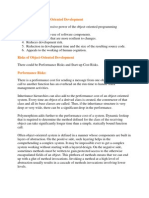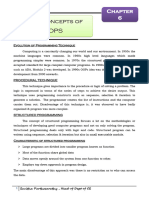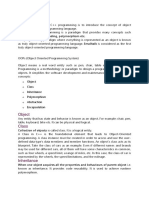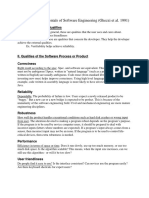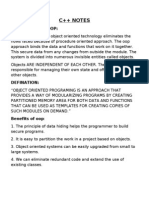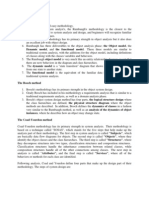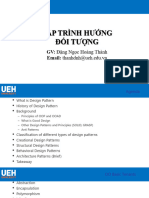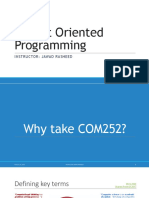Benefits of The Object-Oriented Development
Benefits of The Object-Oriented Development
Uploaded by
kavitarodiyaCopyright:
Available Formats
Benefits of The Object-Oriented Development
Benefits of The Object-Oriented Development
Uploaded by
kavitarodiyaOriginal Title
Copyright
Available Formats
Share this document
Did you find this document useful?
Is this content inappropriate?
Copyright:
Available Formats
Benefits of The Object-Oriented Development
Benefits of The Object-Oriented Development
Uploaded by
kavitarodiyaCopyright:
Available Formats
Benefits of the Object-Oriented Development 1. Exploits the expressive power of the object-oriented programming languages. 2.
Encourages the re-use of software components. 3. Leads to systems that are more resilient to changes. 4. Reduces development risk. 5. Reduction in development time and the size of the resulting source code. 6. Appeals to the working of human cognition. Risks of Object-Oriented Development There could be Performance Risks and Start-up Cost Risks. Performance Risks: There is a performance cost for sending a message from one object to another. A call to another function has an overhead on the run-time to handle stack management activities. Inheritance hierarchies can also add to the performance cost of an object-oriented system. Every time an object of a derived class is created, the constructor of that class and all its base classes are called. Thus, if the inheritance structure is very deep or very wide, there can be a significant drop in the performance. Polymorphism adds further to the performance cost of a system. Dynamic lookup that is required to determine the method defined for the class of the receiving object can take significantly longer time than a simple, statically bound function call. Often object-oriented system is defined in a manner whose components are built in layers of abstraction. On the positive side, such layering helps in the comprehending a complex system. It may be impossible ever to get a complex system working without starting with a layered design. On the negative side, sometimes methods must be written to gain protected access to the otherwise encapsulated fields of an object. This plethora of methods means that we can end up with a glut of method invocations. Invoking a method at a high level of abstraction usually results in a cascade of methods invocations involving lower levels.
Another source of performance bottlenecks is due to the paging behaviour of running applications. Most compilers allocate object code in segments, with the code for each compilation unit (usually a single file) placed in one or more segments. If an operating system funds physical memory bottlenecks and uses the virtual memory concept, then it may result in a higher number of page swapping activities, as most of the function calls in object-oriented applications are across source file boundaries. Dynamic allocation and destruction of objects also contributes to performance costs. Allocating an object on a heap is a dynamic action as opposed to statically allocating an object either globally or on a stack frame. For time-critical applications, the cycles needed for completing a heap allocation may be too costly. A commonly used solution to this problem is to pre-allocate such objects during elaboration of the program. Start-up Cost Risks: Using the object-oriented technology for the first time requires capitalization of the software development tools. If an organization is using a particular object-oriented language for the first time, they usually have no established base of domain-specific software to re-use. A first attempt to use the object technology is usually a failure without the appropriate knowledge and training. An object-oriented language is not just another programming language that can be mastered in a short time period. The mindset shift for object-oriented design may take a long time in most cases.
Basic activities of OOAD:
Object oriented analysis: Analysis is the first stage of the development process. It is also the first step in producing high-performance software. Analysis is central to the performance tuning process. The analysis part having these below steps
OOA process consists of the following steps:
Identify the actors Develop a simple business process model using UML Activity diagram Develop the usecase Develop interaction diagrams Identify classes
Steps involved in OOA process: 1. Actors identification 2. Using UML activity diagram develop a simple business process 3. Develop the use case 4. Prepare interaction diagram 5. Classification-develop static UML class diagram 6. Iterate and refine
You might also like
- Chapter 4 - Programming MethodologiesDocument5 pagesChapter 4 - Programming MethodologiesFreddy MutuaNo ratings yet
- Bit 3201 Object Oriented Analysis and Design Assignments - Docx BKPDocument4 pagesBit 3201 Object Oriented Analysis and Design Assignments - Docx BKPDalnork LapidNo ratings yet
- Advanced Visual Basic 6 Power Techniques For Everyday Programs.9780201707120.24922Document515 pagesAdvanced Visual Basic 6 Power Techniques For Everyday Programs.9780201707120.24922rajeshsasi100% (2)
- Benefits of The Object-Oriented DevelopmentDocument13 pagesBenefits of The Object-Oriented DevelopmentkavitarodiyaNo ratings yet
- Research Paper Summary: Ans:to The Q:no:1Document7 pagesResearch Paper Summary: Ans:to The Q:no:1Al Adnan MehediNo ratings yet
- Assignment yeMADOFODocument3 pagesAssignment yeMADOFOPardon ChiumburukeNo ratings yet
- Benefits and RiskDocument3 pagesBenefits and RiskDASA VIKASH RNo ratings yet
- Oops Unit 1Document59 pagesOops Unit 1Shruti NarangNo ratings yet
- UNIT1 notes for studentsDocument7 pagesUNIT1 notes for studentstawexab191No ratings yet
- All in One OopDocument99 pagesAll in One Oopyaikobdiriba1No ratings yet
- White Paper: A Practical Guide To Identifying Slow Code During DevelopmentDocument5 pagesWhite Paper: A Practical Guide To Identifying Slow Code During DevelopmentDenny RodriguezNo ratings yet
- Materi Perkuliahan Pertemuan 01 - 080317Document47 pagesMateri Perkuliahan Pertemuan 01 - 080317Pahlevi RidwanNo ratings yet
- NganHa Assignment2 Progaming BtecC01k11Document13 pagesNganHa Assignment2 Progaming BtecC01k11Ngân HàNo ratings yet
- Oosad CH2Document8 pagesOosad CH2Malicha GalmaNo ratings yet
- Advantages and Disadvantages of Object-Oriented Programming (OOP)Document2 pagesAdvantages and Disadvantages of Object-Oriented Programming (OOP)anruagNo ratings yet
- CS101 2.1.2 AdvantagesDisadvantagesOfOOP FINAL PDFDocument2 pagesCS101 2.1.2 AdvantagesDisadvantagesOfOOP FINAL PDFSummiya KhanumNo ratings yet
- CS101 2.1.2 AdvantagesDisadvantagesOfOOP FINAL PDFDocument2 pagesCS101 2.1.2 AdvantagesDisadvantagesOfOOP FINAL PDFMayank ChikaneNo ratings yet
- CS101 2.1.2 AdvantagesDisadvantagesOfOOP FINALDocument2 pagesCS101 2.1.2 AdvantagesDisadvantagesOfOOP FINALBetelihem DawitNo ratings yet
- Basics of CPPDocument9 pagesBasics of CPPtejassmm222No ratings yet
- Different Techniques of Software Design: TEAM NO.:-17. Team MembersDocument6 pagesDifferent Techniques of Software Design: TEAM NO.:-17. Team MembersUmesh KumarNo ratings yet
- PPS Notes On CPPDocument19 pagesPPS Notes On CPPAmit KolambikarNo ratings yet
- OOSD Unit-1Document20 pagesOOSD Unit-1kshamatomer2004No ratings yet
- SE Module 3Document6 pagesSE Module 3aswathysethumadhavan.247No ratings yet
- BC0049 Software EngeneringDocument25 pagesBC0049 Software EngeneringRaj ChowdhuryNo ratings yet
- Advantages of OOPDocument3 pagesAdvantages of OOPdnlkabaNo ratings yet
- Object Oriented Concepts: o o o oDocument8 pagesObject Oriented Concepts: o o o oDebapriya DandapatNo ratings yet
- Chap - 6 - Basic Concepts of OopsDocument6 pagesChap - 6 - Basic Concepts of OopspurvikabloreNo ratings yet
- Object Oriented Programming Using Java Final Copy With PedagogyDocument480 pagesObject Oriented Programming Using Java Final Copy With PedagogywerfweNo ratings yet
- 1SPM NoteDocument126 pages1SPM Notenmadhura14No ratings yet
- Activity Lesson 13 Software ReuseDocument2 pagesActivity Lesson 13 Software ReuseDawn Lyndell TamayoNo ratings yet
- Assignment On ComputerDocument8 pagesAssignment On Computerolah godwinNo ratings yet
- Object: C++ Oops ConceptsDocument5 pagesObject: C++ Oops Conceptsiamsaravanan06No ratings yet
- Benefits of OOP: ReusabilityDocument2 pagesBenefits of OOP: Reusabilityaarthy31No ratings yet
- Fundamentals of Software EngineeringDocument4 pagesFundamentals of Software EngineeringJoão MotaNo ratings yet
- Evaluation of OopDocument32 pagesEvaluation of OopVenu Gopal33% (3)
- 0220048602-23-Tec 211-2013-Kw3a-16-0220048602-23-Tec 211-2013-Rp3a-16-166 - PDocument4 pages0220048602-23-Tec 211-2013-Kw3a-16-0220048602-23-Tec 211-2013-Rp3a-16-166 - PTulus Indra FernandezNo ratings yet
- Fundamentals of OOPsDocument19 pagesFundamentals of OOPsBipin BhadraNo ratings yet
- System Development Life CycleDocument3 pagesSystem Development Life CycleGaurav100% (1)
- OopusingcDocument9 pagesOopusingcapi-213911742No ratings yet
- sOFTWARE REUSEDocument48 pagessOFTWARE REUSENaresh KumarNo ratings yet
- DR - Jyothirmayi Degree College, Adoni.: Paper-III - Object Oriented Programming Using C++: Unit-1 FundamentalsDocument65 pagesDR - Jyothirmayi Degree College, Adoni.: Paper-III - Object Oriented Programming Using C++: Unit-1 FundamentalshafsaadnNo ratings yet
- Silver Bullet Short NotesDocument3 pagesSilver Bullet Short Notesomkar kaleNo ratings yet
- Unit 5 PPSDocument27 pagesUnit 5 PPSpratikkakade101No ratings yet
- Java Unit IDocument84 pagesJava Unit Inaninani102112No ratings yet
- Unit 2Document23 pagesUnit 2mr yashNo ratings yet
- Java OopsDocument163 pagesJava Oopsarnavytstudio2814No ratings yet
- Object Oriented Programming NoteDocument99 pagesObject Oriented Programming NoteaayushNo ratings yet
- Expert SystemDocument7 pagesExpert SystemGeorge Johnson ClayNo ratings yet
- Introduction To Object Oriented Programming: Se E&Tc Academic Year 2017-18 Sem - II Academic Year 2017-18 Sem - IIDocument16 pagesIntroduction To Object Oriented Programming: Se E&Tc Academic Year 2017-18 Sem - II Academic Year 2017-18 Sem - IIchristopher KazauraNo ratings yet
- Design Patterns SW Quality - English VersionDocument18 pagesDesign Patterns SW Quality - English VersionAdemir Constantino100% (1)
- EC104 Unit4Document21 pagesEC104 Unit4Dhara Milan PatelNo ratings yet
- Effects of Oop AssignmentDocument4 pagesEffects of Oop Assignmentsibhat mequanintNo ratings yet
- Notes Oopm Unit 1Document38 pagesNotes Oopm Unit 1elishasupreme30No ratings yet
- CPP With Oop NotesDocument64 pagesCPP With Oop NotesFor RewardsNo ratings yet
- Software Development Thesis SampleDocument5 pagesSoftware Development Thesis Sampledqaucoikd100% (2)
- Software Framework - Wikipedia, The Free EncyclopediaDocument4 pagesSoftware Framework - Wikipedia, The Free EncyclopediaRabin KoiralaNo ratings yet
- Assignment No.: - 2 Ques:1 List The Principles of OOSE With Its Concepts. Ans:1Document11 pagesAssignment No.: - 2 Ques:1 List The Principles of OOSE With Its Concepts. Ans:1Sweta UmraoNo ratings yet
- Activity 2 DemopDocument10 pagesActivity 2 DemopJacqueline AlegríaNo ratings yet
- Object Oriented Software Engineering ManualDocument41 pagesObject Oriented Software Engineering ManualDevyani PatilNo ratings yet
- Applications of StacksDocument17 pagesApplications of StackskavitarodiyaNo ratings yet
- What Is A Web Service or Some Relevant Web Services: (For) Developing Applications For Real-Time Environmental DataDocument24 pagesWhat Is A Web Service or Some Relevant Web Services: (For) Developing Applications For Real-Time Environmental DatakavitarodiyaNo ratings yet
- The Rumbaugh MethodDocument2 pagesThe Rumbaugh MethodkavitarodiyaNo ratings yet
- The Rumbaugh MethodDocument2 pagesThe Rumbaugh MethodkavitarodiyaNo ratings yet
- Data Mining and Knowledge Discovery Course ParticipantsDocument43 pagesData Mining and Knowledge Discovery Course ParticipantskavitarodiyaNo ratings yet
- Assignment No 3 NewDocument5 pagesAssignment No 3 NewKrushna DeoreNo ratings yet
- Ooad Unit-3Document21 pagesOoad Unit-3KCPDNo ratings yet
- Remote - Sensing - & - GIS - 2023 10 26 16 18 48Document45 pagesRemote - Sensing - & - GIS - 2023 10 26 16 18 48kbmailer3No ratings yet
- Chapter 01 - Introduction To OOP and JavaDocument48 pagesChapter 01 - Introduction To OOP and JavaTanveer Ahmed HakroNo ratings yet
- Curriculum - BITS BSC CSDocument10 pagesCurriculum - BITS BSC CSjinop79764No ratings yet
- Rhino RDK DocumentationDocument13 pagesRhino RDK DocumentationVictor LopezNo ratings yet
- Engineering en 1 PDFDocument395 pagesEngineering en 1 PDFVishwanath ReddyNo ratings yet
- Experment 5 AIM: To Draw The Structural View Diagram For The ATM: Class Diagram, Object DiagramDocument6 pagesExperment 5 AIM: To Draw The Structural View Diagram For The ATM: Class Diagram, Object DiagramRisha SinghNo ratings yet
- WeblinkugDocument338 pagesWeblinkugJosephi_abbas100% (1)
- Cse Syllabus R 2009Document87 pagesCse Syllabus R 2009MATHANKUMAR.SNo ratings yet
- Uid Mod 1Document10 pagesUid Mod 1Sangeetha krNo ratings yet
- 02 TA80 INTG020 GosuForIntegrationDocument30 pages02 TA80 INTG020 GosuForIntegrationathiraviswanath02No ratings yet
- EclassifiedsDocument59 pagesEclassifiedsanand_kushwaha_3100% (1)
- B8. Design Patterns EnDocument146 pagesB8. Design Patterns EnNgọc ThạchNo ratings yet
- db2 Sec Guide 115Document392 pagesdb2 Sec Guide 115TrurlScribdNo ratings yet
- Lecture 01Document103 pagesLecture 01Hatice AkgülNo ratings yet
- Modern Systems Analysis and Design 8th Edition Valacich Test BankDocument32 pagesModern Systems Analysis and Design 8th Edition Valacich Test Bankaxillatutorialij8j100% (37)
- X Practice PaperDocument10 pagesX Practice Paperhargunnkaur31802No ratings yet
- Hyv Bca Part 2 SyllabusDocument24 pagesHyv Bca Part 2 SyllabusHEMANT MOHBEKARNo ratings yet
- 454u6 - Elective I - Grid ComputingDocument20 pages454u6 - Elective I - Grid ComputingArjun Reddy100% (1)
- Top 50 Salesforce Interview Questions and AnswersDocument20 pagesTop 50 Salesforce Interview Questions and Answersajay gadiparthi100% (3)
- Finaluris Bileti 2 1Document4 pagesFinaluris Bileti 2 1nino gudadzeNo ratings yet
- Introduction To C Part 3Document48 pagesIntroduction To C Part 3nitin rakhNo ratings yet
- OOPs Unit-4 and Unit-5 NotesDocument53 pagesOOPs Unit-4 and Unit-5 Notescst1No ratings yet
- Some Communication Problems of KB Controlled Manufacturing SystemsDocument6 pagesSome Communication Problems of KB Controlled Manufacturing SystemsNacsa JánosNo ratings yet
- C++ Classes and ObjectsDocument4 pagesC++ Classes and ObjectsAll TvwnzNo ratings yet
- The Solid Principles SlidesDocument37 pagesThe Solid Principles SlidesAbdul Hafeez MunawarNo ratings yet
- 8 Implementing Methods in A ClassDocument6 pages8 Implementing Methods in A Classsinghashwanicoder25No ratings yet
- F-IoT Unit-3Document94 pagesF-IoT Unit-3Harshini Reddy RevuriNo ratings yet



